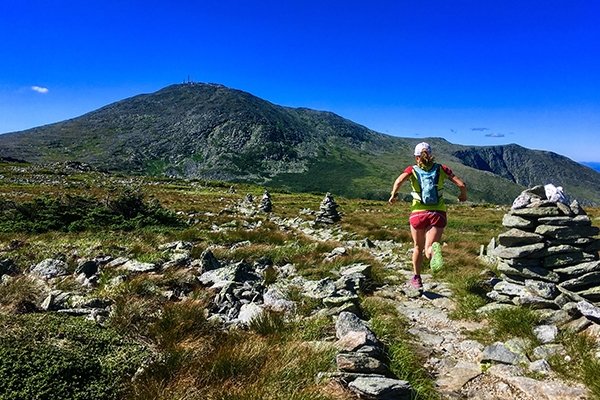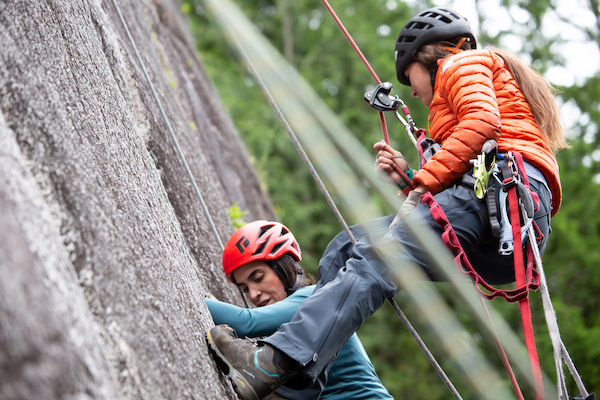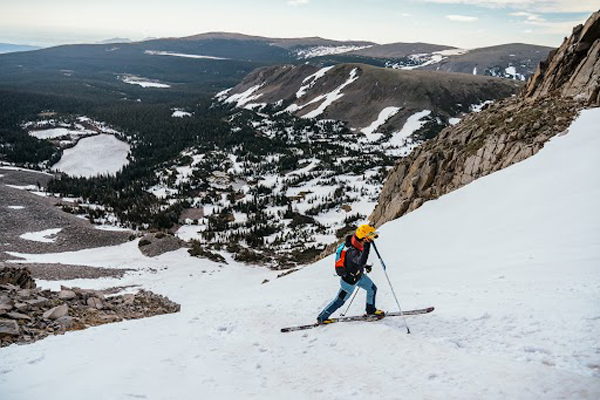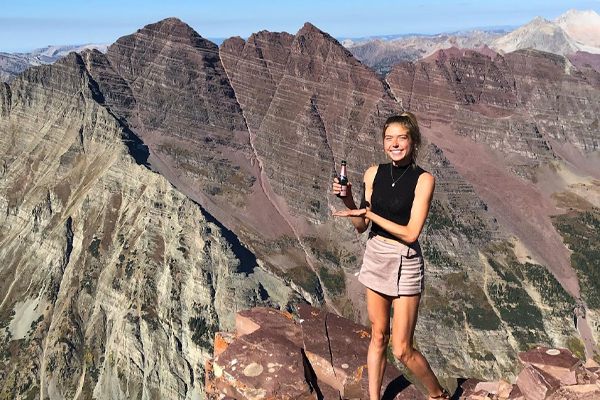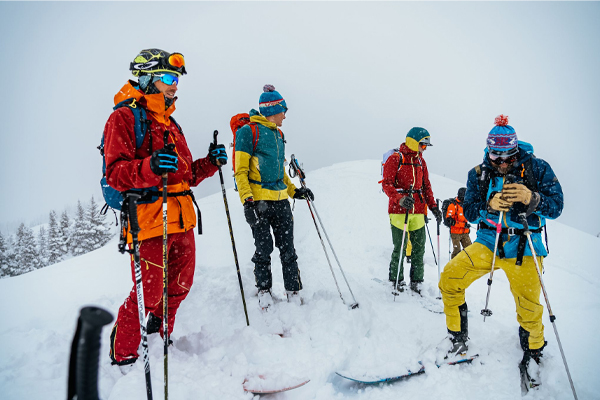Chris Kalman - Establishing New Routes

After seventeen years, there is no doubt about it—developing new routes is my favorite way to climb...
- - -
The sense of adventure, the mystery beyond the next piece of protection, the intimacy with which you touch and test each hold, all of this provides a richer sensory experience than I’ve ever achieved climbing something with a known grade, length, and descent.
Because new routing is such an intimate experience, it has always made me feel deeply connected to the land. That connection, I believe, is the seed of stewardship. With the very concept of public lands under attack in our own country, and mountains around the world under constant threat from extractive industries, that kind of stewardship is more important than ever before. It is not enough for climbers to simply play in the mountains; they need to protect them.
It is in hopes that more first ascentionists means more climbing stewards that I share some hard-earned knowledge I’ve gleaned from almost a decade of first ascents in Chile, the US, and Canada. I hope this article will encourage you to go find your own adventures out there in the mountains, and come back inspired by your experiences to fight for them.
Picking a Line
Start climbing without a guidebook. Seriously, this can lead to a massive paradigm shift in how you look at walls that aren't already filled out. The lines are not so abstract as they may seem, nor is the process. Start on the ground and look for macro-features like dihedrals, pillars, and ramp systems. These are the building blocks of a new route. Get a sense of the steepness of the wall by looking at it from many different angles. Is it slabby? Can you connect weaknesses through free climbing? How featured is the stone? Figure out how tall the wall is, and break it into roughly 100 to 200-foot chunks. These are your pitches. If three of those chunks look completely blank, that may be 300 to 600 feet of bolted face climbing, or in the range of 30 to 60 bolts. Get some binoculars and look again. Is there a small crack? Flakes that may provide intermittent protection? The big question is whether the line you’ve picked is something you can climb in a style that agrees with your (and with local) ethics. Just about anything can be climbed—just not necessarily in good style.
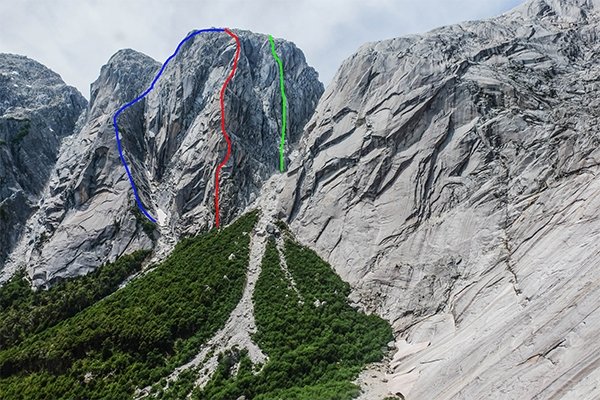
A few successful new routes, taken from the middle of an aborted new route! You win some, you lose some. Blue: "El Filo La Aleta de Tiburon" (10 pitches, 5.10+, Haenel-Kalman-Siadak); Red: "The Doppler Effect" (16 pitches, 5,12b, Kalman-Moore-Varney); Green: "Siete Venas" (10 pitches, 5.12b, Hardgrove-Kalman-Kelly-Oakley).
Assemble Your Gear
What you should bring depends a ton on the ecosystem in which you’re climbing. For example, if you’re in the Pacific Northwest, you may want to bring a variety of gardening tools to help clean out cracks (also bring solid knowledge about local flora/fauna and land manager rules and regulations). In the Sierra Nevada where it tends to be dryer and more alpine, you can often get away without a single brush. If the rock is super featured, you may not need a bolt kit. If you are putting up 1000 feet of friction slab, you’ll definitely need bolts. No matter where you are, rely first and foremost on natural protection. This means being creative with your rack: invest in offset cams, maybe get a rack of totems, offset brass and small pieces are a must. Pitons are invasive but not as much so as bolts - especially smaller ones like bird beaks, RURPs, and knifeblades. Bring extra long slings, and extra carabiners. No matter how much of those you have, they always get used.
To Bolt or Not to Bolt
In rock climbing, there are few subjects as contentious as bolting. There’s no sinle guiding principle: it depends on past precedent in the area you’re climbing, whether you want others to repeat your route or not, whether placing a bolt might save you from death or injury, or may cause you death or injury (if you are hand drilling, this latter possibility is quite real). Whatever you decide to do, think before you drill. Placing a bolt is an irrevocable act. You can patch holes with quickcrete and rock dust, but even the best patch jobs are often still visible. Hammer around to make sure the placement is solid, make sure there’s really not any natural gear possible, make sure you’re not too close to the last pro, or the next pro. Be patient, and ask yourself, “is this really a good place for a bolt?”

Chris Kalman hammering in a bolt low on Cerro Walwalun in Cochamo.
Rappel, or Ground Up?
Some people prefer to rappel a line to see if it goes first, but I would advise against this. There is so much beauty in the experience of confronting the unknown. The moment you inspect a hold, pitch, feature, you’ve robbed yourself of that experience. That said, going ground up can lead to dangerous routes with poorly placed or positioned hardwear. If climbing ground up leads to an X-rated line in prime real estate, consider going back and making it safe for others on rappel. Adding bolts or removing dangerous flakes won’t erase your memory of the first ascent, and most guidebook authors will be happy to say something to the effect of “this route was established ground-up on three bolts, but was later retro’d so more average climbers could enjoy it.” That’s a win-win.
Establishing the Descent
I’ve seen this time and again: someone puts a lot of effort into a new route, and then, they make a crappy rap line. No matter how classic your climb is, if the descent is sketchy, uncomfortable, or unnecessarily difficult, your line will be reviled. Long raps are nice, but only if the rope pulls are clean, and the stances are comfortable. It’s great if your rap line can simply follow the route, but that’s not always the safest line with the cleanest pulls. Look for stances for anchor locations, and clean sweeps of slab. Don’t force long raps simply in order to save time, or bolts.
Listen to Locals
There’s no one set of principles that applies to every crag and mountain range. Tap in to the local scene before you start a new line. This usually means spending a lot of time in the area, meeting and climbing with locals. Definitely spend more time on the wall than on internet forums. First ascensionist tend to be active and motivated, and spend more time working on climbs than spraying about them. Put in enough hours and pitches, and you’re guaranteed to run into folks who are “in the know.” Offer to help them with their projects before you ask them to help you with yours. You not only stand a better chance of succeeding, you also are less likely to inadvertently do something that doesn’t jive with the local community.
Consider Non-Climbers
As climbers, we often forget that there are other user groups that enjoy the places we love to climb, and don’t necessarily agree with our behaviors. For example, climbers are pretty heavy handed when it comes to cleaning vegetation off walls to expose climbable rock features. If you’re planning to remove veg, make sure you know what kind of veg you’re removing. Is it endangered? Is it loved by local naturalists? Is it habitat for a rare or endangered bird? This applies to everything in the new routing process, which tends to be higher impact than simply repeating climbs. Non climbers tend to be way less excited about climbing’s impact than most climbers are, so try to minimize that impact. Build a sustainable trail to your route to minimize erosion. Paint bolt hangers to blend in with the rock. If you use fixed lines, make sure they blend in with the rock, too. If you’re going to drill, or use other power tools, don’t do it on a busy Saturday.
Know How to Self Rescue
What makes new routing so fun is also what makes it so dangerous: you have no idea what you’re going to find up there. On top of that, most new routing these days is done somewhere pretty remote. It’s imperative to bring self-rescue knowledge to the table when you go to climb something new. Any time a rescue is initiated, especially in high angle environments, rescuers are put at risk as well. If you and your partner can get yourselves off the mountain, you minimize the risk to other people’s lives. Remember, nobody owes you a rescue. You put yourself in this situation. You are responsible for knowing how to get out of it, too. That means you need to know how to escape a belay, how to do a belayed lower of an unconscious partner, how to assess an injury, how to rappel with a diminished rack, and countless other bits of mountain savvy. If all of that sounds incredibly daunting to you, you’re probably not ready to new route responsibly. That’s okay, of course, and shouldn’t turn you off. It just means it’s time to start educating yourself on these things.
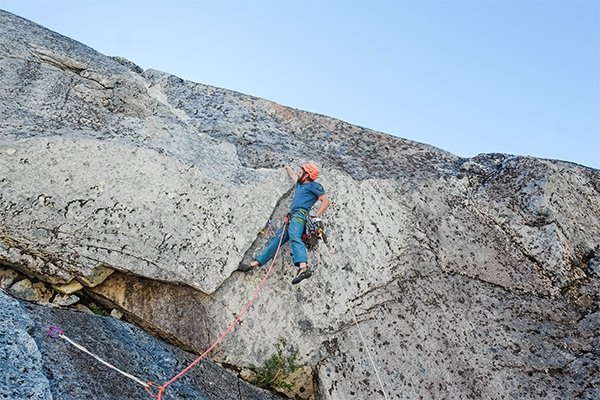
The overhanging flake on "No Hay Hoyes" (6 pitches, 5.11a).
Think Before you Spray
Is the route really done? Is it really safe? Is it really as good as you think it is? Is it somewhere with delicate access? Is promoting your route likely to make that wall, that mountain range, that community better? Or worse? Not all routes need to be promoted. I’ll always remember what Kelly Cordes wrote about Mugs Stump a few years ago in an article for Alpinist Magazine “Stump had a recurring dream that he had completed, alone, one of the finest lines in the Alaska Range. He'd left nothing behind and kept the experience to himself. One evening in a bar, some climbers arrived, energized by a well-earned first ascent. Others joined in the celebration, hearing stories about the route, the very same line Stump had soloed. In his vision, he quietly joined in, raising a toast to their success.” Putting up a new route is really cool. But pulling a Mugs Stump? That would be ice cold.
Be Humble in Victory, Gracious in Defeat
I’ve had the good fortune to stumble upon (or have shown to me) a number of lines that have gone on to become popular routes. There was a time when hearing speak praise for my lines made my heart swell with pride. Of course, this is nonsense. Those routes are great because the scenery is spectacular, and the natural features of the stone lend themselves to some classic elements (consistent difficulty, dramatic positioning, safe but exciting, etc). My partners and I didn’t build the walls. We bear little responsibility for how fantastic these lines are. Don’t take undue credit if you pick a plum. If you do, you’ll set yourself up for failure when you don’t get so lucky. Sometimes you fail. The crack ends in unclimbable slab. The rock quality deteriorates. Deadly flakes block further progress. Things happen. Sometimes you get to the top, sometimes you don’t. Sometimes the rock you are climbing turns out to be five stars, sometimes one. If you do fail to put up a classic —or even a route at all—don’t let it bring you down. I’ve seen people cheat themselves of their own beautiful experiences simply because they were obsessed with reaching the top. Any day in the mountains is a good, and beautiful one. Even if you don’t reach the top. There’s no such thing as failures, just false starts.
Photos: © Megan Kelly


